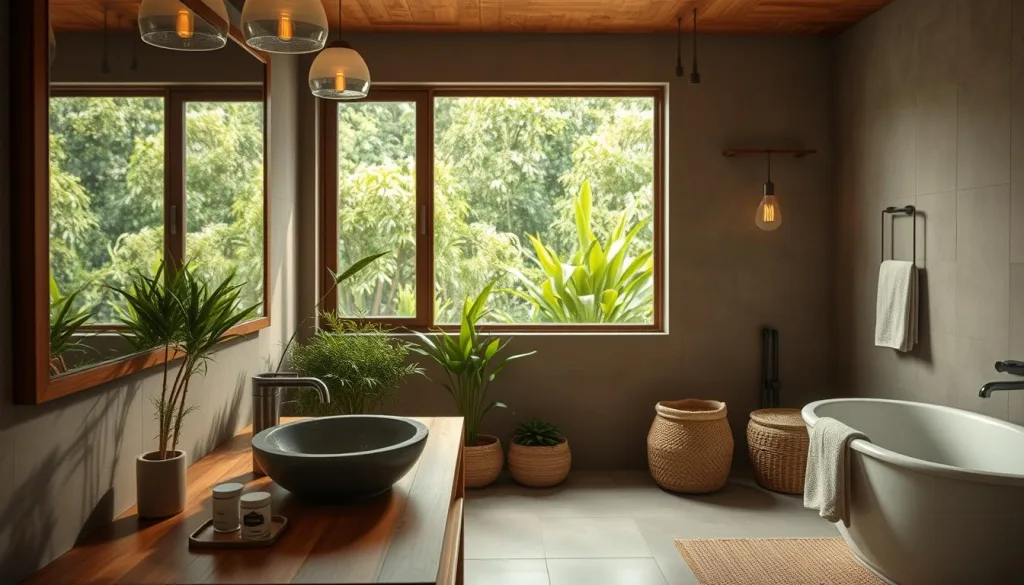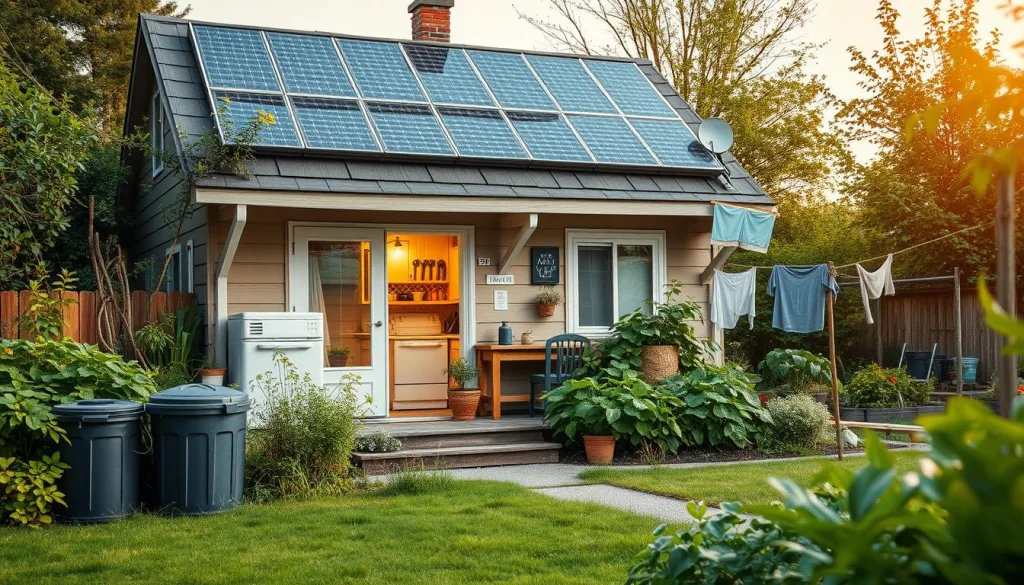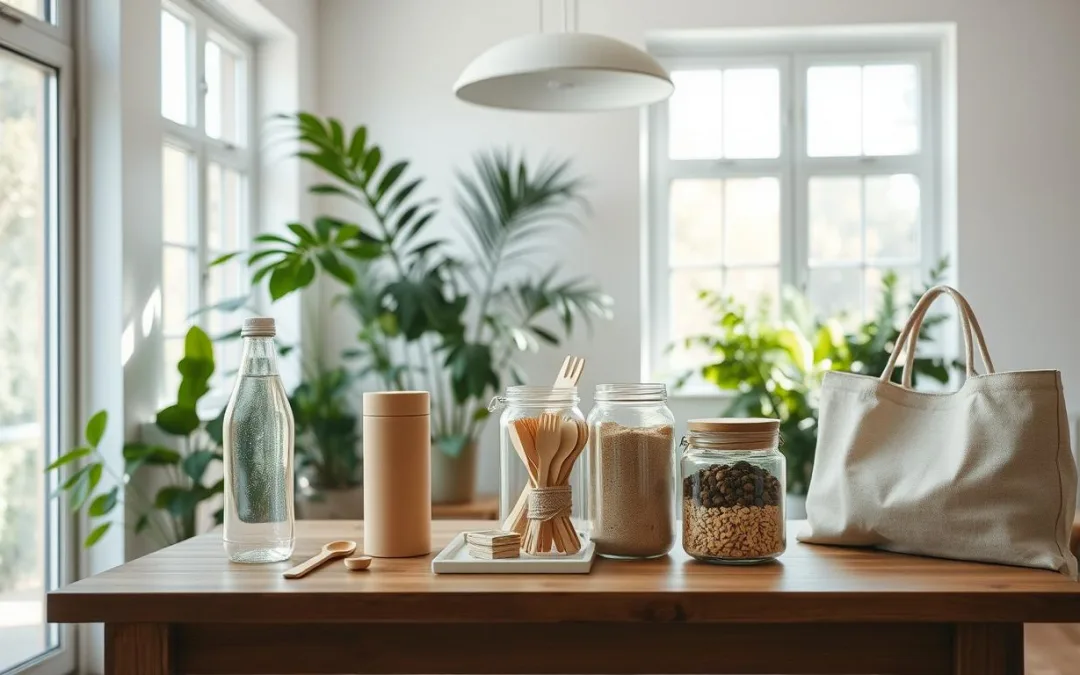In the United States, we generate a lot of waste. Americans throw away between 250 and 400 million tons of garbage each year. This is a big problem for our environment. Zero waste living tips can help us make a big difference by choosing sustainable options.
Living zero waste is more than just recycling. It’s about changing how we buy and use things. By following sustainable living ideas, we can lower our carbon footprint and help the planet.
The zero-waste movement asks us to think differently about how we use resources. Making small changes in our kitchens and personal care routines can have a big impact on the environment.
Key Takeaways
- Zero waste living reduces individual environmental impact
- Small changes can lead to significant waste reduction
- Sustainable practices save money and resources
- Individual actions contribute to global environmental health
- Zero waste is a holistic approach to consumption
Understanding the Zero Waste Movement
The zero waste movement is a big change in how we live and consume. As waste keeps growing, it’s key to learn about it for a cleaner life.
What Zero Waste Really Means
Zero waste isn’t about making no trash at all. It’s about making smart choices to cut down waste. This guide will show you the main ideas:
- Refusing unnecessary items
- Reducing what we buy
- Using what we already have
- Recycling the right way
- Composting food waste
The Impact of Waste on Our Planet
The harm from waste is huge. The UN says waste will jump from 2.1 billion tonnes in 2023 to 3.8 billion tonnes by 2050. In the U.S., each person throws away over 4.5 pounds of trash every day.
| Waste Category | Annual U.S. Generation |
|---|---|
| Total Municipal Waste | 275 million tonnes |
| Recycled Municipal Waste | 69 million tonnes |
| Plastic Packaging Recycled | 3 million tonnes |
Breaking Down the Linear Economy Problem
The old linear economy takes, makes, and then throws away. Zero waste living wants a circular economy. This way, things keep getting used over and over, cutting down waste a lot.
Only 9% of global plastic is recycled, showing we need big changes fast.
Getting Started with Zero Waste Living Tips
Starting a zero waste journey might feel daunting, but it’s all about small steps. Eco-friendly living tips work best when you’re patient and set realistic goals. The EPA says Americans throw away about 292.4 million tons of trash each year. Only 35% of it gets recycled or composted.
To begin your sustainable living journey, first understand your waste habits. I suggest doing a personal waste audit to find areas for improvement. This helps you see where you can cut down on waste.
- Conduct a comprehensive waste audit of your household
- Create a zero waste starter kit with essential reusable items
- Set achievable waste reduction goals
- Practice mindful consumption
Green living is about getting better over time, not being perfect. Studies show you can save about $1,200 a year by buying more mindfully. Every small step you take makes a big difference for the planet.
Remember: A zero waste lifestyle is a journey, not a destination.
Here are some key tips for beginners:
- Invest in reusable alternatives
- Minimize single-use item consumption
- Learn basic repair and upcycling skills
- Connect with local zero waste communities
By following these tips, you’ll slowly change your lifestyle and reduce your impact on the environment. The goal of zero waste isn’t to produce no waste at all. It’s about making choices that reduce waste as much as possible.
Essential Zero Waste Kitchen Transformations
Turning your kitchen into a zero waste space is a big step towards less waste at home. A typical household can cut food waste by 30-40% with smart strategies. This makes a big difference for the environment. By adopting eco-friendly habits, you can make your kitchen more sustainable, save money, and help our planet.
Kitchen waste is a big problem for our planet. Sustainable living bundles offer great tools for reducing your environmental impact.
Bulk Shopping Strategies
Bulk buying cuts down on packaging waste and saves money. Here are some tips for zero waste shopping:
- Bring reusable containers to bulk stores
- Purchase dry goods like grains and spices in bulk
- Invest in high-quality, durable storage containers
Bulk buying can cut packaging waste by up to 60%. It can also save you 10-30% compared to buying pre-packaged items.
Food Waste Prevention Methods
Stopping food waste is key for a green kitchen. Try these methods:
- Plan meals in advance
- Use a first-in, first-out storage system
- Use all parts of vegetables
- Freeze leftovers for later
Pro tip: Americans throw away 6.2 cups of food each week. By planning meals for 85% of what you need, you can cut down on waste a lot.
Sustainable Food Storage Solutions
Good food storage helps keep food fresh longer and reduces waste. Here are some eco-friendly options:
- Use glass containers instead of plastic
- Try beeswax wraps for fruits and veggies
- Use silicone bags for leftovers
- Learn how to store produce properly
By following these zero waste tips, you can make your kitchen more eco-friendly. This will help your wallet and the planet.
Sustainable Bathroom and Personal Care Practices

Turning your bathroom into an eco-friendly space is a big step towards green living. Your personal care routines can greatly reduce waste and harm to the environment. By adopting sustainable practices, you can significantly lessen your impact on the planet.
Water saving is key in making your bathroom more sustainable. Did you know that an average American uses about 400 gallons of water each month just from showering? Making a few simple changes can make a big difference:
- Install low-flow shower heads to save up to 20% water
- Reduce shower time by 2-5 minutes to save water and energy
- Use water-efficient toilets that can save 3,000 gallons a year
Choosing plastic-free personal care items is a big step towards living more sustainably. Here are some great alternatives:
- Switch to bamboo toothbrushes instead of plastic ones
- Use safety razors instead of disposable plastic razors
- Use reusable containers for personal care products
- Make your own shampoo and conditioner bars
“Small changes in our daily routines can create substantial environmental impact.” – Sustainability Expert
Zero-waste personal care products might seem pricey at first. But they can actually save you money in the long run. For example, safety razor blades cost about $2.50, while disposable razors can cost over $12. Bamboo toothbrushes can last up to a year, cutting down on plastic waste.
Looking into brands like Plaine Products can also help you on your sustainable journey. They offer aluminum-packaged, vegan personal care products that eliminate single-use plastics and provide quality alternatives.
Creating a Zero Waste Shopping Routine
Changing how you shop is a big step towards zero waste. Americans throw away about 4.4 pounds of waste daily. By making small changes, you can help the environment a lot. Start your waste-free journey with simple steps.
Living sustainably starts with how we shop. The EPA says we should reduce waste first. By planning your shopping, you can lessen your impact on the planet.
Building Your Reusable Shopping Kit
Building a zero waste shopping kit needs thought. You’ll need:
- Reusable cotton grocery bags
- Mesh produce bags
- Glass containers for bulk items
- Cloth bags for bread and dry goods
- Stainless steel water bottles
Navigate Packaging-Free Shopping
Smart shopping means finding bulk stores and farmers markets. Buying in bulk can cut packaging waste by 90%. Look for stores that let you bring your own containers. Always ask about package-free options.
Making Smart Consumer Choices
Being mindful of what you buy is essential. Here are some tips:
- Buy in larger quantities to reduce packaging
- Choose products with minimal or recyclable packaging
- Prioritize quality over quantity
- Support local and package-free businesses
Zero waste living is a journey. Small, steady changes can cut your waste by 50%. This makes a big difference for our planet.
Minimizing Household Waste and Energy Consumption

Reducing waste at home is more than just recycling. It’s about changing how we live to use less energy and make less waste. The World Bank says global waste will grow by 70% by 2050. So, we all need to start living more sustainably.
Here are some easy ways to cut down on waste and energy at home:
- Implement the Five R’s: Refuse, Reduce, Reuse, Recycle, and Rot
- Invest in energy-efficient appliances
- Optimize home insulation
- Practice mindful water consumption
Energy use is a big problem. The average U.S. home uses 11,000 kilowatt-hours a year. This is a lot of room for improvement.
| Waste Reduction Strategy | Potential Impact |
|---|---|
| Digital billing | Reduces paper waste by up to 80% |
| LED lighting | Saves 75% energy compared to incandescent bulbs |
| Smart thermostat | Decreases energy consumption by 10-15% |
Changing how we manage waste needs effort and planning. By following these tips, homes can lessen their impact on the environment. Plus, you might save money on bills.
Every small action counts in the journey toward sustainable living.
Working together and learning more is key to making zero-waste living work. The zero-waste movement is growing. It shows more people care about the planet.
Sustainable Fashion and Textile Practices
The fashion world is a big problem for our planet, causing about 10% of global carbon emissions. What we wear affects more than just our style; it impacts the health of our planet. Learning about sustainable fashion is key to living better for our Earth.
Textile waste is a huge issue. In 2018, 11.3 million tons of it ended up in U.S. landfills. Every time we buy clothes, we make a choice that affects our planet’s future.
Building a Conscious Wardrobe
To build a sustainable wardrobe, we need to think carefully. Here are some tips to change how we shop for clothes:
- Invest in high-quality, versatile pieces that last longer
- Choose timeless designs over fast fashion trends
- Prioritize brands with transparent sustainability practices
- Consider multifunctional garments that reduce overall consumption
Clothing Care and Repair
Keeping clothes in good shape helps reduce waste. Simple steps can make a big difference:
- Learn basic mending skills
- Wash clothes less frequently
- Use gentle, eco-friendly detergents
- Repair instead of replacing when possible
Ethical Fashion Choices
“Every garment you choose is a vote for the kind of world you want to live in.” – Sustainable Fashion Advocate
Ethical fashion is more than just style. Here are some tips for making better choices:
- Shop second-hand and vintage
- Participate in clothing swaps
- Support brands with circular fashion models
- Explore clothing rental services
By choosing our clothes wisely, we can lessen our impact on the planet. Together, we can make a difference, one outfit at a time.
Conclusion: Making Zero Waste Living Sustainable Long-Term
Zero waste living is more than a trend; it’s a way to protect our planet. The market for zero waste is growing fast, showing we’re all committed to living sustainably.
Your path to living eco-friendly doesn’t stop with personal actions. Joining your community is key. Groups like the Minnesota Zero Waste Coalition prove that together, we can make a difference. Every small step, like cutting down on waste or helping local green projects, helps a lot.
Living sustainably is always getting better. With new ideas and inventions, we’re moving forward fast. By staying updated, choosing eco-friendly brands, and making smart choices, you join a worldwide effort to change how we use resources.
Zero waste isn’t about being perfect; it’s about getting better. Every little thing we do, like using less plastic or supporting the circular economy, brings us closer to a greener future. Your choices count, and together, we can make a big difference for our planet.
FAQ
What exactly is zero waste living?
Is zero waste living really possible for the average person?
How much money can I save by adopting a zero waste lifestyle?
Where should I start my zero waste journey?
What are the biggest challenges in zero waste living?
How can I reduce food waste in my home?
Is zero waste living more expensive?
How can I convince my family to support my zero waste efforts?
What are the most impactful zero waste swaps I can make?
How does zero waste living help the environment?
Source Links
- Starting an eco-friendly lifestyle: tips for zero waste living — Polly Barks – https://pollybarks.com/blog/zero-waste-lifestyle-guide
- Embracing Zero Waste Living | Green City Times – https://www.greencitytimes.com/embracing-zero-waste-living/
- Zero Waste Is a Climate Change Solution – Eco-Cycle – https://ecocycle.org/learn-about-zero-waste/zw-is-a-climate-change-solution/
- Ultimate Guide to Going Zero Waste Living | Zero Waste – https://www.zerowaste.com/blog/how-to-go-zero-waste-get-started-and-ditch-the-single-use-life/
- From Landfills to Reuse: Understanding the Zero Waste Movement – ClearCOGS – https://www.clearcogs.com/blog/from-landfills-to-reuse-understanding-the-zero-waste-movement/
- 20 Zero Waste Living Tips For Producers & Consumers | Folene – https://folenepackaging.com/blog/zero-waste-living-tips/
- Discover How To Start A Zero Waste Lifestyle – Roll’eat® – https://rolleat.com/how-to-start-a-zero-waste-lifestyle/
- Zero Waste: A Beginner’s Guide – https://learn.eartheasy.com/guides/zero-waste-a-beginners-guide/
- How to go zero waste – https://davidsuzuki.org/living-green/how-to-go-zero-waste/
- How to Be a Zero Waste Kitchen with SuperBee’s Guidance – https://superbee.me/how-to-be-a-zero-waste-kitchen/?srsltid=AfmBOooBY_bneV16jOAcEl89Kne_scMIj1qTNyXr21-ukru3fyiv1bk3
- Achievable Strategies for a Sustainable Lifestyle – Jasmin Ilkay, MPH, MBA, RDN – https://jasminilkay.com/mastering-zero-waste-in-your-kitchen-achievable-strategies-for-a-sustainable-lifestyle/
- 16 Smart Tips for Zero Waste Living Without Spending a Fortune – https://www.greenwashingindex.com/tips-for-zero-waste/
- My Zero Waste Shower: Eco Friendly Shampoo, Bamboo Scrub Brush, & More – Going Zero Waste – https://www.goingzerowaste.com/blog/my-zero-waste-shower/
- Practical ways to make your bathroom eco-friendly— and save some money, too – https://www.nbcnews.com/select/lifestyle/12-practical-ways-make-your-bathroom-eco-friendlier-save-some-ncna1061246
- How to Formulate a Zero Waste Bathroom & Self Care Routine ⋆ Earth and Water – https://earthandwater.co/zero-waste-bathroom-self-care-routine/
- What I learned from adopting a ‘zero waste’ lifestyle (it wasn’t as easy as I thought) – https://www.cnbc.com/2018/11/14/how-to-start-a-zero-waste-lifestyle.html
- Zero waste living guide for beginners – Earth5R – https://earth5r.org/a-beginners-guide-to-zero-waste-living-2/
- How to Create Less Waste From Grocery Shopping – https://mindfulofthehome.com/zero-waste-grocery-shopping-tips/
- Zero Waste 101: Reducing Your Footprint – Payless Power – https://paylesspower.com/blog/zero-waste-101-reducing-your-footprint/
- Zero Waste Living: Practical Tips for Minimizing Household Waste – https://www.implasticfree.com/zero-waste-living/
- Wearing (an almost) zero-waste wardrobe: sustainable fashion tips – Inspire – https://inspire.ehe.osu.edu/2022/10/07/wearing-an-almost-zero-waste-wardrobe-sustainable-fashion-tips/
- Six Innovative Practices for Fashion Brands to Reduce Waste and Boost Sustainability – https://www.fittdesign.com/blog/sustainable-fashion-six-innovative-practices-for-fashion-brands-to-reduce-waste-and-boost-sustainability?srsltid=AfmBOooVzNCHAvutdmPsuYV39F1RmAhHypOsoWsUnLxpsJxo9GOEcpYR
- 16 Sustainable Zero Waste Tips – https://www.greenmatch.co.uk/blog/zero-waste-tips
- What Is Zero Waste and How to Achieve It – https://www.theethicalfuturists.com/what-is-zero-waste-and-how-to-achieve-it/
- How to Live a Zero Waste Lifestyle: 11 Tips for Zero-Waste Living and Smarter Shopping – sustainabilitybyvance – https://www.sustainabilitybyvance.com/how-to-live-a-zero-waste-lifestyle-23-tips-creative-reuse-and-smarter-shopping


